No time to read this? Why not find something to study instead? A1 – Beginner/Elementary | A2 – Pre-Intermediate | B1 – Intermediate | B2 – Upper-Intermediate | C1 – Advanced | C2 – Proficiency | What’s my level? | Italian level test
+++
Buondì.
Earlier this week I was checking out the SERP for one of our various websites, that being a nice, easy job I reserve for moments when I don’t have the ‘voglia’ to do anything more useful.
Basically, I have a list of ‘search’ terms (that’s the ‘S’), which I copy and paste into Google (both the ‘S’ and the ‘E’), then trawl through the pages of results that appear (the ‘P’ and the ‘R’) to see where our particular site appears, if at all, and which other sites are present.
For instance, if you paste or type ‘learn Italian’ into Google, you should see the club website (though Google shows different results to different people…) along with other websites competing for your attention. Look carefully to see what they’re selling. Everyone’s selling something, including us.
Anyway, I was doing this for our online lessons site NativeSpeakerTeachers.com, which will be running a free trial lesson promotion next week (for details of that, scroll way, way down, to the P.S.), and in particular, I was looking at search terms like ‘German lessons online’.
Mostly our site was nowhere in the SERP for German, which was no surprise as 1.) there’s a lot of competition, and 2.) we don’t bother much with languages which aren’t Italian, so don’t really care.
However, because I’ve been pondering learning some German, I was paying more attention to the SERP then I usually do with such a pedestrian task. This site came top for my search term, followed by this one, and literally dozens of others.
The effect this had on me was similar to when I’m walking down the ‘Wines’ aisle of a supermarket: I’m interested, I start comparing what’s on offer and how much things cost, I evaluate the possibilities based on my existing preconceptions of what offers value.
It’s a Sangiovese, ‘Riserva’ it says on the label, but branded by a mass-market bottler, so unless they’re doing something very different, it’s probably overpriced at five-plus euros. Ah, and the alcohol by volume is low for the price range. I’ll pass.
Just like wines, language courses cost more or less, according to the marketing (primarily who’s providing them and how they’re communicating that to you), and of course the specifications: self-study courses cost the least, or should do, group courses with a teacher cost more, and one-to-one courses most of all.
Also just like wines, there are a host of things to look out for besides the basics (red, white or rosé? still or sparkling? low, medium or high price range?)
If there’s a teacher, how many ‘contact hours’ do you get for your cash? If self-study, how much material is available, and of what type? If a mix of the two approaches, what can you get for free, and how useful/stimulating does it appear to be?
Back in the day, language learners had the option of buying a self-study course of some sort from a bookstore or by mail order, or of signing up for an actual course (like this one), either in their home town or in the country where the language they wanted to learn was spoken, thereby choosing to learn in a classroom with a teacher and other students.
Those choices still exist, of course, but there are a range of other options, including materials/courses/apps which are completely free, and ‘freemium’ business models (users get some things for free, but are enticed to pay extra for other things.)
So where to begin with my German,?
Languages are so BIG, there’s SO MUCH TO LEARN, and there are SO MANY OPTIONS!
The temptation then, as I freely admit, despite being a language-learning professional (and regular wine-buyer), is to go with the promises of the most-visible, most credible-looking providers.
I always check out the bottles displayed at the end of the aisle, the ones you can’t help seeing when you walk by, which change each week (because supermarkets charge producers a fee to display their bottles there…)
In Google I look at the top ‘organic’ results on the first page, which may need some scrolling, as ‘sponsored’ results – the ones that advertisers pay for – come first.
Hopefully I’ll find there a reasonable mix of the best options, though if I’m making a decision that matters, I’ll scroll through the first 10 pages of results looking for interesting outliers.
Important to bear in mind though, however good or bad my choice of a course, I’d still be choosing that particular learning route, rather than self-study, or some hybrid.
Which has both pros and cons.
With the course, for instance, it’s likely structured in such a way that if an average participant does this, she gets that, end of story.
Do this whole course, or these modules of a larger course, and the result should be that. It’ll take you this number of hours or weeks.
Then, if you wish, you can continue with this other course, which will take that amount of time, and get you that result.
And the costs are…
The primary ‘pro’ is the appearance of certainty, which makes the decision easier, and reduces anxiety about doing something new.
The main ‘con’ is that it’s ‘one-size-fits-all’, and ‘unisex’ to boot.
That’s not how I selected what to wear this morning, and I suspect it won’t necessarily suit me as a language learner either.
The course might be too easy, too hard, too boring, or involve too much grammar. And if I’m not happy?
Take it or leave it. You pay this, you get that (if you show up, and do what we tell you…) Now sign here, please.
Or – and this is a common and reasonable approach – I could skip the paid-for course options, at least for now. In fact I could skip paying for anything at all, and see how I’d get on with ‘just’ the free material.
I was looking at a Beginner’s German course offered by a respected UK university, which would have taken up thirty or so hours of my valuable time doing self-study (no teacher was involved) and cost me nearly £200.
I didn’t dismiss the option immediately, but reading on I discovered that there was a Beginner’s German 2, a Beginner’s German 3, and so on.
Doing the maths in my head, I figured that I’d end up paying north of a thousand British pounds, still wouldn’t have completed the first CEFR level, A1, and presumably would have done zero actual speaking.
Yeah, right. So maybe I’ll cover the basics on my own, with free material, and find a native speaker to chat with online?
The pros: that’d be cheaper than a course, much more flexible, and so potentially faster, too, as I could skip anything that didn’t seem relevant.
The cons: I’d need to captain my own ship, so to speak. And if I ran it into the rocks, I’d have only myself to blame.
So what have I decided to do about the German?
For the moment, nothing.
Instead, I’m devoting the time to reading/listening more in Swedish, French and Spanish (plus Italian, of course).
Things are still busy at home with our house guest, Bug, who’s coming up to eighteen months of age and so takes up considerable time and energy.
I’m therefore ‘consolidating’, rather than starting something new.
Then, when my time is once more my own, I might make the course/self-study decision based on other factors: a long-frustrated desire to travel, to spend more time with other adults, to take a break from working from home, and so on.
Perhaps it won’t matter which wines I drop in my trolley, or why.
As long as there’s plenty to drink with dinner!
Alla prossima settimana.
Climb the ‘Italian Comprehension Ladder’: 50% Off This Month
(Copied and pasted from our ebooks store…)
What’s a ‘comprehension ladder’?
Suppose you want to improve your understanding of written and spoken Italian, from a basic level up to a point at which you feel confident dealing with real Italian texts and audio recordings.
Practice with ‘graded’ materials will help build your skills and confidence, each gradation (or ‘level’) being like a step on a ladder.
You climb to the first step, then the next, and another and another, until soon… you’ve high above where you began!
Check out the eleven rungs in our ‘Italian Comprehension Ladder’, all of which will be 50% off the usual ‘easy reader’ price for the next few weeks.
Use the free sample chapters and links to the free online audio to select which rung of the ladder to begin your climb from.
Or grab them all, while they’re half-price!
L’appuntamento – level A1 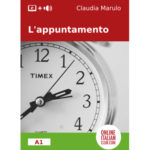
Stefano and Chiara have known each other since they were children but, as they live in different places, have to make arrangements if they want to meet. Today they’ve agreed to see each other. Stefano has something important he wants to ask Chiara…
Buy now -50% | Free sample (.pdf) | Free online audio | Other ebooks at A1
Mistero al Circo Garotti – level A1-A2 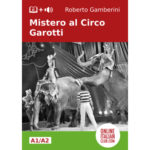
The Circo Garotti is the most famous circus in Italy. But lately its owner, Alvise, has been troubled by the disappearance of some of the circus’s performing animals… Can Alvise find out the truth behind these mysterious events?
Buy now -50% | Free sample (.pdf) | Free online audio | Other ebooks at A1/A2
La montagna – level A2 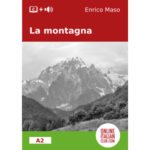
Three friends decide to spend a weekend trekking in the mountains, as they used to do when they were younger…
Buy now -50% | Free sample (.pdf) | Free online audio | Other ebooks at A2
Quando suonano alla porta – level A2-B1 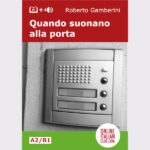
After an evening of wine and streaming TV series, singleton Stefano is asleep on his couch, surrounded by books and pizza boxes. But at five a.m. the doorbell rings…
“Stefano! Stefano apri, ti prego!”
Di chi è questa voce? Chi è che batte con forza alla porta di casa mia?
“Stefano, sono Laura. Per favore, apri, è un’emergenza!”
Buy now -50% | Free sample (.pdf) | Free online audio | Other ebooks at A2/B1
La volta buona – level B1 
“In Italia ci sono circa 1.200 canili e rifugi per cani. In queste strutture vivono circa 120.000 cani. In Italia esiste una legge che impedisce il sacrificio dei cani in canile. Però, solo il 30% dei cani abbandonati viene adottato da una nuova famiglia. Il resto passa la vita in una prigione.”
Gigio is overweight and has skinny legs so, unless there’s food on offer, he moves slowly, or not at all. His cellmate, Pablo, is a ‘cane corso’, a large, powerful and intimidating dog. The human, Carola, who brings their meals often tells Gigio, “Pablo è un cane alfa, tu no… Tu sei un pacifista.” It’s just as well, thinks Gigio!
Only the most heartless students of Italian will read Gigio’s entertaining ‘prison diaries’ without wondering whether they’ve space at home for a dog…
Buy now -50% | Free sample (.pdf) | Free online audio | Other ebooks at B1
Le vie del cuore – level B1-B2 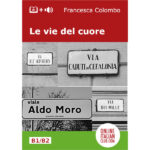
In your home town, street names may have been chosen by a city planner hoping to orientate you, by a developer so as to evoke pleasant images in your mind (and so raise real estate prices), or by local leaders to commemorate an important person, place or event. At the very least, they’ll be familiar to you. But in another country? The names of Italy’s piazze, strade and vie can often seem mere strings of hard-to-remember syllables, devoid of any meaning to visitors from afar…
But no! Take a little time and – with the help of this ‘easy reader’ ebook – you’ll soon know as much as any local!
Chi visita più di una città italiana, trova alcuni nomi di vie e piazze molto ricorrenti: sono i nomi di personaggi celebri e importanti, di date significative o di luoghi con un valore storico o sociale. Per esempio, in molte città italiane c’è una “Via Leonardo da Vinci” o una “Piazza Dante Alighieri” in onore del grande genio e del famoso autore della Divina Commedia. Ci sono anche tante “Via Roma” in ricordo della splendida capitale…
E poi ci sono un sacco di nomi ed eventi sconosciuti o quasi. Per esempio: chi diamine era Giuseppe Mazzini? Perché è famoso Enrico Fermi? E cosa è successo il 4 Novembre?! Conoscere i personaggi e i fatti che danno il nome a molte strade e piazze delle città del Bel Paese è un po’ come fare un tuffo nella cultura italiana. Allora, siete pronti a tuffarvi?
Buy now -50% | Free sample (.pdf) | Free online audio | Other ebooks at B1/B2
Per colpa di una lettera – level B2 
One morning Albina gets an unexpected visitor – because of a letter!
“Arrivo, arrivo! Che diamine! Un po’ di pazienza!” strilla Albina con voce acuta e civettuola, mentre qualcuno bussa insistentemente alla porta della sua piccola ma elegante casetta a due piani. È convinta che sia uno dei suoi ammiratori che le porta un mazzo di fiori.
Buy now -50% | Free sample (.pdf) | Free online audio | Other ebooks at B2
La diaspora italiana – Italiani negli Stati Uniti – level B2/C1 
A ‘diaspora’ is a population that lives somewhere different from their original home, or that of their forebears. Since the late nineteenth century, millions of Italians have emigrated in search of better prospects. By 1980 it was estimated that twenty-five million Italians had made their home outside of Italy, in countries all over the world…
Secondo il censimento del 2010, gli Italo-americani sono 17.250.000 e corrispondono al sesto gruppo etnico più numeroso negli Stati Uniti d’America.
Gli Italo-americani si sono distinti nei più diversi settori della società. Nel campo dell’invenzione, per esempio, ricordiamo Antonio Meucci, il padre del telefono, e la famiglia di origine friulana Jacuzzi, che ha prodotto le famose vasche da bagno.
In ambito sportivo si sono distinti, fra gli altri, il mitico giocatore di baseball Joltin’ Joe (Giuseppe Paolo) di Maggio, sposato per qualche anno con la diva Marilyn Monroe e citato in una famosa canzone di Simon and Garfunkel, e poi il campione dei pesi massimi Rocco Francis Marchegiano, meglio conosciuto come Rocky Marciano, the Brockton Blockbuster.
Anche nel mondo dello spettacolo non mancano cognomi italiani: da Frank Sinatra a Leonardo di Caprio, da John Turturro a Madonna (alias Veronica Ciccone) a Frank Zappa, passando per Robert De Niro, Jake LaMotta, Joe Pesci, Liza Minelli, Al Pacino e Jon Bon Jovi… La lista è lunghissima!
E, infine, un buon numero di italiani di prima, seconda, terza o quarta generazione hanno contribuito a governare il paese. Per esempio, Fiorello La Guardia è stato sindaco di New York negli anni della Grande Depressione.
“Little Flower”, così era chiamato (traduzione letterale del suo nome italiano), ha amministrato con grande onestà ed efficienza la città e ne ha rilanciato l’economia.
Buy now -50% | Free sample (.pdf) | Free online audio | Other ebooks at B2/C1
Il miracolo del paese – level C1 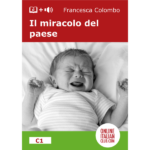
Italia, circa sette anni dopo la Prima Guerra Mondiale e la successiva influenza spagnola, che insieme avevano decimato la popolazione giovane e fertile di Villalba, un piccolo paese nel nord d’Italia
Fuori dalla casa di Luigia c’era un gruppetto di persone che si guardava in attesa. Il marito di Luigia, che stava per diventare padre, mostrava tutta la sua preoccupazione.
“Voi credete che sia normale? Tante ore per…”
Il parroco sbottò, quasi fosse offeso: “Certo che è normale, abbi fede nel Signore, che diamine! Le cose ben fatte son lunghe da farsi!”
Marcello chiese scusa, rammaricato per aver messo in dubbio i piani del buon Dio. Ma in quel momento qualcuno gridò: “È nato, è nato!”
Buy now -50% | Free sample (.pdf) | Free online audio | Other ebooks at C1
Tumulto a Firenze – level C1-C2 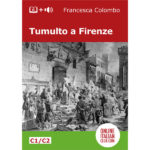
The thrill of revolution!
Nel 1378 la situazione sociale, politica ed economica della Repubblica di Firenze è precaria. La città è stata fortemente debilitata dalla Peste del Trecento e da una recente guerra contro lo Stato Pontificio. La nobiltà cittadina e il “popolo grasso” (ricchi banchieri e imprenditori) aumentano dunque la pressione nei confronti dei lavoratori salariati (soprattutto lavoratori della lana).
Nel dialetto toscano, “ciompare” significa battere, colpire, picchiare. Si definivano dunque “Ciompi” i battilana. Vi erano molti tipi di lavoratori di tessuti, e i Ciompi sgrezzavano la lana. Si occupavano solo della fase iniziale e più dura della lavorazione.
Nell’estate del 1378, a fronte di uno scontro tra nobili e corporazioni, anche i poveri salariati si riversano in città. In un primo momento il loro numero e la loro disorganizzazione sono sconcertanti. Presa coscienza della propria superiorità numerica e supportati inizialmente dalle Arti, i lavoratori della lana, detti Ciompi, iniziano a esigere diritti politici.
“Svelto, Luigi, prendi le armi!” mio padre aveva fatto irruzione, tutto trafelato, nel retro della casa. Io e mia sorella Angela, che stavamo battendo la lana, interrompemmo il lavoro.
“Quali armi? Che succede babbo?” chiesi sorpreso.
“Non c’è tempo, ti spiego durante il cammino… tu prendi il coltellaccio, che non si sa mai!” Mi strinse una spalla con la mano. Gli lanciai uno sguardo interrogativo ma obbedii.
Buy now -50% | Free sample (.pdf) | Free online audio | Other ebooks at C1/C2
La carriera – dietro le quinte del Palio di Siena – level C2 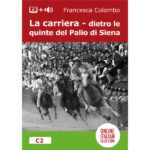
“E mancano solo quattro giorni al Palio, la corsa di cavalli più famosa d’Italia!”
sebbene la radio gracchiasse, si distinguevano piuttosto chiaramente le parole dell’esaltato commentatore: “Siena freme e si dipinge dei colori delle contrade, agghindate per la festa. Come ben sapete, cari ascoltatori, tra le dieci contrade che gareggiano vi sono alleanze e rivalità secolari. Per ogni contrada è stato già estratto a sorte un cavallo. I migliori di quest’anno sono il giovane Trifoglio, che è al suo secondo palio e corre per la contrada dell’Istrice, e la veterana Caruccia che vestirà i colori della Lupa. La Lupa e l’Istrice sono due storiche rivali, che fatalità, signori! Se ne vedranno delle belle!”
Follow Il Guercio, the diminutive one-eyed Sardinian jockey, as he’s hired to ride one of the year’s best horses, bareback, in Italy’s most famous urban race, the Siena Palio!
Buy now -50% | Free sample (.pdf) | Free online audio | Other ebooks at C2
P.S. Free Trial Lesson Offer Next Week!
Learning Italian/French/Spanish/German?
Next week our sister website NativeSpeakerTeachers.com will be running their semi-annual Free Trial Lesson promotion.
Regular online meetings with a native speaker teacher of the language you’re learning help give structure to your self-study, and are essential to practice speaking and interacting!
But many students are anxious that one-to-one lessons might not be right for them. We were nervous ourselves, before we tried being online students!
So why not take the chance to do just the one, for free, while the promotion is on?
There’ll be details of how that works in next week’s email. Watch this space!
P.P.S.
Don’t forget to read/listen to Tuesday’s FREE bulletin of ‘easy’ Italian news.
The regular text + audio bulletins are a fantastic, FREE way to consolidate the grammar and vocabulary you’ve studied, as well as being fun and motivating.
Take a look at their website (it’s FREE!)
You can get all three text + audio bulletins of ‘easy’ news emailed to you each week, on Tuesdays, Thursdays and Saturdays. That’s also FREE!
Enter your email address on this page then click the confirmation link that’s sent to you.
+++
OnlineItalianClub.com | EasyItalianNews.com | Shop (ebooks) | Shop (online lessons)

Lynne F says
You are preaching to the converted here Daniel! No better way to understand grammar and build vocabulary than listening, speaking and reading..Like a child learning their native language I have progressed from just one word to phrases, sentences and whole conversations. During the summer history series, you provided a link “Se questo e un uomo” I could read it, and now I am listening to it on Rai radio Ad alta voce” where there is a wide range of audiobooks. If anyone is interested.
My objective at the start of my Italian journey was to “get by” when on holiday in Italy and I have surpassed that. Not by learning vocabulary lists ,conjugating verbs and completing grammar activities but by listening, reading and speaking.. The latter being supported by a small group of Italian individuals who have become friends.No timetable., no homework no curriculum just people who want to improve their italian/ Englishand chat about things that interest them
Daniel says
Thanks for the tip, Lynne. My wife was just telling me today that she’s into audio books (she gets them from the library app…) so I passed it on to her.
There’s an index of RAI audio books here, for anyone who’s interested: https://www.raiplaysound.it/programmi/adaltavoce/audiolibri
I took a quick look at this one https://www.raiplaysound.it/audiolibri/illibrodellagiungla to check for geoblocking and so on. The text is out of copyright, so probably free for anyone. Scroll down for the other 14 chapters, each one is approximately 20-25 minutes long.
This is native-speaker level stuff, so likely too hard for most club members. Having the text to read while you listen would make it easier, but audiobooks like this are likely to use an abridged version…
As an alternative (not free) check out our own ‘easy readers’ which are text + audio, and graded by level: https://easyreaders.org/catalogue/